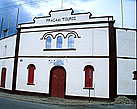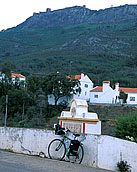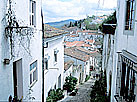
Trip April 2000
Best way to bicycle the Alentejo, Portugal
Cycle in a commercial group bike tour.
Bike Rating: Excellent
Click on any picture in this column
|
|
Distant hill town across plowed fields. |
|
Extremely bumpy local road leads down to border river with Spain |
|
Stork on Chimney near Monsaraz. |
|
Biker taking a sample from a harvested cork tree along the road. |
|
Praca do Touros - Bull Fighting Ring. |
|
People watching. |
|
Entrance to Casa de Peixinhos, an historic private home, turned hotel. |
|
The town of Villa Viçosa. |
|
Below Marvão. |
|
Typical hill town street. |
|
Hill town in northern Alentejo. |
|
Nature of the Ride: The Alentejo, literally the province across the Tejo River, is a mainly flat, arid land filled with scrub oak, cork trees, olive groves, vineyards, a few fields, and whitewashed hill towns. As you proceed from South to North, the land gains elevation. Yearly precipitation increases. Pastures and orchards begin to make their appearance. The Alentejo, from South to North, occupies about 2/5ths of the length of Portugal. It is ounded on the east by Spain, on the south by the Algarve coast, to the west by the Atlantic Ocean, and to the northwest, and north by the province of Lisboa et Vale do Tejo. Never a fertile or resources-rich land, if today the villages are becoming more wealthy, it is in large part due to the return with their savings of those who worked in France, Germany, and Switzerland. From the biker's point of view, the Alentejo has four advantages: It is full of natural charm; it is relatively free of traffic and tourists; it is warm and dry earlier in the spring and later in the fall than the rest of Europe; and it is inexpensive: You can sleep in high quality hotels and pousadas (government hotels in historic buildings) at moderate cost. You will cycle, in the Alentejo, almost entirely upon highways (and, locally, upon village streets, and bumpy roads). On most highways, fortunately, automobile circulation is light, and trucks are few and far between. Most restaurants serve copioius amounts of simple, plain, local food. Though many riders like these meals, they are far from gourmet. The pousadas, on the other hand often do serve more complex meals. The Alentejo has many excellent potters, and beautiful earthenware pieces may be obtained at reasonable prices, carried in luggage, and used at home. Other handicrafts, while enticing, are less practical. When to Go: The ideal months to bike in the Alentejo are March and April. May is much hotter, with highs in the 80s, but still a good month for biking. In the summer, temperatures are scorching and rainfall minuscule. Temperatures remain quite warm into the month of October, but the countryside is parched and sere. It is rainy and cold throughout the winter. Attractions: The Alentejo has a variety of open landscapes, described above, that make riding enjoyable. But the icing on the cake are the charming, whitewashed hill towns, many along the so called "castle route". Each town is different; each more attractive than the next. There are a few "tourist sights", for example, a ducal palace that belonged to the Portuguese royal family, and a breeding farm for some of Europe's finest horses, open for group tours. Here and there are sprinkled dolmens, Moorish fountains, and historic churches. Information on sights may be found on the Portuguese government web site: http://www.visitportugal.com . How to bike it: The following difficulties are involved in self-organizing a trip: Biking out of Lisbon requires use of major highways and bridges The distance from Lisbon to the main tourist area is about 175 kilometers. Little English is spoken. Bike shops are uncommon. However, it is possible to self-organize a trip.Thanks to Evan White, who self-organized such a trip, for his input on this. You should carry any bicycle repair tools and supplies you might need. If your group is large, you might want to consider hiring a van one or both ways, perhaps through Lisbon Taxi, perhaps meeting you directly at the airport. Although expensive, the other costs of the trip are very reasonable when compared to France or northern Europe, so the total cost of the trip may still fall within your budget. Biking out of the airport is on major highways, and is ill advised. Another option is the train. The Portuguese train Internet site is not easy to use. The best bet may be to take your bicycle by cab from the airport to a Lisbon lodging, and to arrange your trip at the railroad station or perhaps a local travel agent. If you will be biking from south to north, possible destination stations are Beja, Viana, or Évora. Return station possibilities are Elvas or Abrantes. Intercity trains to not carry assembled bicycles, but should take cycles packed in bike bags. See my discussion of home made, portable bike bags, here. Regional trains do usually carry assembled bicycles. Using regional trains may involve several transfers to reach your destination. Train fares are reasonable. It may be economic and desirable to use taxis or vans from your starting or ending towns to regional train stations to avoid major highways. The author normally bikes on self-organized trips. The Alentejo, however, seemed to be best biked with an organized group. On a typical organized bike circuit through the Alentejo you will ride about 330 kilometers — 200 miles. The first and last days of your trip you will be transported by van from and to Lisbon. The author's well-run trip was with perhaps the only commercial touring company to cover this area, Easy Rider Tours: (http://www.easyridertours.com), Itinerary: Because the Alentejo is not particularly suitable for an individual tour, and because the author has no organizational experience in Portugal, no itinerary is given. Individuals interested in constructing their own tour can obtain ideas from the above mentioned government tourism site, and from the general itineraries published by bicycle touring companies on the web. The key Alentejo tourist towns, from south to north, are Mértola, Serpa, Beja, Alvito, Monsaraz, Evora, Arrainlos, Vila Viçosa, Estremoz, Portalegre, Castelo de Vide and Marvao. You could also combine the Alentejo with other parts of Portugal if you have more than one week of time free to cycle. |










